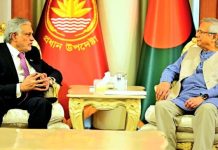Ali Basit
“O ye who believe! Take your precautions, and either go forth in parties or go forth all together”
Al Quran – Surah An Nisa
Each year, 6th September is celebrated to pay homage to the martyrs who laid down their lives while defending the country during 1965-war. On this memorable day, the people of Pakistan stood united as one solid edifice to meet the onslaught of an enemy that chose the cover of darkness to achieve its heinous ends of occupying our motherland. It is relevant to recount the achievements so that the present generation is also aware of the past events, and do not fall a prey to the propaganda of detractors of Pakistan. The coordinated action of the Pakistan Army, Navy and Air Force from Lahore, Karachi, Runn of Kutch to Chamb Jorian, had made all sectors the graveyard of ruined dreams of Indian leadership and army commanders who had dreamt of celebrating victory in Lahore. Pakistan with a relatively small armed forces and limited resources had indeed given adequate response to the enemy on all fronts including air, land and sea.
On 6th September, India’s attack against Lahore was held and beaten back with heavy losses to the attackers. The Pakistan Army units defending on the ground, supported by the Pakistan Air Force were able to blunt the Indian offensive and roll it back. Two days later on 8th September, India launched its main attack against Sialkot using its armored division and other strike formations. What ensued has been described as the largest tank battle since the Second World War. It was a hard and bitter struggle fought over many days and night’s resulting in casualties on both sides. In the end the Indian main attack was held and severely mauled. Its armored division was force to withdraw owing to very high losses in men and material. South of Lahore, Pakistan launched its own counter attack and captured Indian areas of Khem Karan and beyond. This posed a serious threat to the rear of Indian troops facing Lahore. During 6th and 7th September, Pakistan Air Force had also proved its mettle by continuous air attacks from Pathankot to Agra; for the loss of only 06 aircraft, PAF had destroyed 50 enemy aircraft on ground and in the air, and damaged 08, not counting the undermined losses inflicted by PAF’s night bombing.
On naval front, despite numerical less in size Pakistan Navy (PN) conducted a number of operations for creating strategic deterrence and offering a befitting response to Indian Navy. The prowess exhibited by PN ensured that Pakistani waters and sea lanes remain operational for ships coming to Pakistani ports. Pakistan Navy had played its part by launching a successful ‘Operation Dwarka’, vehemently destroyed the Indian Radar system which was guiding Indian Air Force to launch attacks against Pakistan. The core objective of ‘Dwarka’ was multi-fold in effect as it was not only aimed at destruction of the radar but to provoke Indian warships stationed at erstwhile Bombay (now Mumbai) port to come to the Arabian Sea where Pakistani submarine “Ghazi” was prowling and waiting to engage enemy’s ships namely INS Vikrant and INS Mysore to dock out and get destroyed. This maneuver had adversely affected the Indian Navy’s operational plans. Operation Dwarka was launched on 8th September and the bombardment on identified targets was completed in merely four minutes.
Having transcendence in operational preparedness, Pakistan navy is no less at meeting the regional and international maritime security obligations. Post 9/11 maritime security operations were being conducted in Arabian Sea and Indian Ocean Region, Pakistan Navy being part of Coalition Maritime Campaign Plan under UN mandate, has actively participated in maritime security and counter-piracy operations. Though a smal…
[14:03, 04/09/2021] Uzma NAVY: 6TH SEPTEMBER: WHEN IT BECAME CLEAR THAT PAKISTAN IS INVINCIBLE
By Adnan Yousuf
6th September is marked as Defence Day of Pakistan which is celebrated each year across the nation to pay tribute to the brave sons of the soil, who sacrificed their lives while defending Pakistan during the 1965 War. It was a momentous day in the history of Pakistan when the war-mongering India invaded our motherland. But our armed forces with the people of Pakistan on their backs, stopped the Indian attacks dead in their tracks and the dream of the Indian Army to celebrate the evening at one of Lahore’s most well-known addresses, was broken into pieces.
In order to familiarize the young generation with the history of Pakistan and the sacrifices of their forefathers, the achievements of Pakistani forces must be recounted so that the younger ones may not be misled by false information propagated purposely by Pakistan’s enemies and opponents.
Pakistan’s armed forces have always played a substantial role in protecting its territorial integrity by rigorously dealing with any emerging threat or inimical situation. In fact, they know very well how to payback our enemies. The Indian side has been presenting severe challenges to Pakistan since 1947, but the acquiring of strategic capabilities has helped Pakistan turn back India’s malign intentions. The Pakistan Navy, along with the Pakistan Army and Air Force, defended the territorial water zones both during war and peace. Pakistan Navy’s history is filled with glory and eminence, exquisite skills and calamitous maneuverability, and tactical feats to defeat even the larger naval forces.
In the Indian offensive that began on 6th September, the joint action of the Pakistan Army, Navy, and Air Force effectively fended off the offensives and taught her a hard lesson on land, air, and maritime fronts. Two days after the initial attack, India employed its armored division and other striking formations to take Sialkot on 8th September. Resultantly, a large tank battle followed the largest since World War II. There were casualties on both sides in this bitter and long-lasting conflict fought over many days and nights. Eventually, the Indians were mauled and held. A very high loss of both men and materials forced India’s armored division into withdrawal. Immediately after the Sialkot attack, Pakistan waged a counter-attack in the south of Lahore and seized Indian territories of Khem Karan and beyond. As a result, the rear of the Indian troops facing Lahore was greatly threatened. In these two days, Pakistan Air Force also gave the enemy a tough time by launching continuous airstrikes from Pathankot to Agra. Besides the collateral damage caused during the night bombing, PAF destroyed 50 Indian aircraft and damaged eight for the loss of only six Pakistani aircraft.
On sea fronts, Pakistan Navy, despite having a comparatively lesser size and offensive capability, conducted several operations in order to create strategic deterrence and respond to the Indian Navy appropriately. As a result of the Pakistan Navy’s nautical prowess, the sea lanes and waters surrounding Pakistan remained open to incoming ships.
The major role Pakistan Navy played in the 1965 Indo-Pak War was launching the ‘Operation Dwarka. On 7th September, PN sailed battle-tested and capable seven ships with 24 guns for Dwarka. Dwarka was enforcing a blackout and only identifiable by radar, but the lighthouse provided a very good point of reference in terms of positioning for the task force. Executing the ‘Operation Somnath’ every ship was authorized to fire 50 rounds of high ammunition. The ships opened fire from a distance of 5.5 to 6.3 miles, still closing the range. Approximately, four minutes was all it took to fire the allocated number of shells, and quickly alter course to exit the area.
On checking damage at Dwarka on 8th September, Indian navy officials acknowledged the damage caused as a result of this action. They found the radar station destroyed; the naval air station’s runway for test flights of INS Vikrant damaged; about 50 persons dead and a nearby cement factory also damaged. This official version of the Indian naval officials confirm that the Pakistan navy’s raid on Dwarka had been a stunning success as not only a massive material and psychological damage was done to the enemy but also Indian air raids on Karachi ceased, implying the radar station was knocked out.
The Pakistani fleet arrived back in home waters minutes after the attack, assumed their patrol stations 100 miles off Karachi, and ready for a possible Indian response, which through possible radar contacts were observed, never materialised. The sole Indian warship in the area, the Whitby Class frigate Talwar, had been undergoing repairs to her condensers in Okha and had not challenged the raid.
The Pakistani Navy’s strategic thinking and war planning cornered the Indian Navy as their operational plans were adversely affected. The PN had undertaken Operation Dwarka to achieve multiple objectives: destructing the Indian radar, and provoking its war craft stationed at Mumbai (then Bombay) port approach the Arabian Sea, where PN’s submarine ‘Ghazi’ was awaiting to engage and destroy Indian ships namely INS Vikrant and INS Mysore.
Having already proven its operational readiness, the Pakistan navy does not fall short when it comes to meeting the regional and international obligations in maritime security. The Pakistan Navy, as a member of the Coalition Maritime Campaign Plan under UN mandate, has actively participated in maritime security and counter-piracy operations after 9/11. The Pakistan Navy has the highest share in maritime security campaigns after the United States, despite being a small naval force. Through its coordinated efforts, the PN has excluded merchant ships from the danger zone which had previously been paying war risk surcharge due to piracy. As a further step to support the international effort in the region, the Pakistan Navy has established Regional Maritime Security Patrols (RMSP), aimed at ensuring maritime security at sea to protect trade. Such PN’s initiatives have enabled Pakistan to manifest its role at large as a reliable regional and international maritime player.
The exemplary role played by Pakistan’s armed forces in general and the Pakistan Navy in particular in showing the world that Pakistan’s defence is invincible makes it inevitable to emphasize that soldiers need their people’s support to fight the enemy with courage and bravery. So, this Defence Day, we should pledge as a nation that we will always remember the sacrifices of our brave soldiers and will stand by their side in the war and peace. We should also study the modern tactics used by the enemy to weaken our state, and pray that may God give us the strength, ability, and courage to protect our freedom and the honor of our motherland at all costs.

















